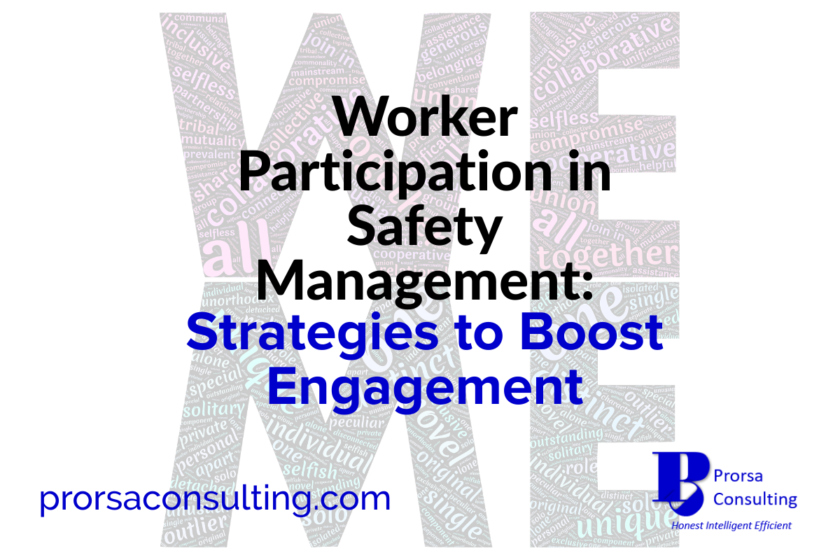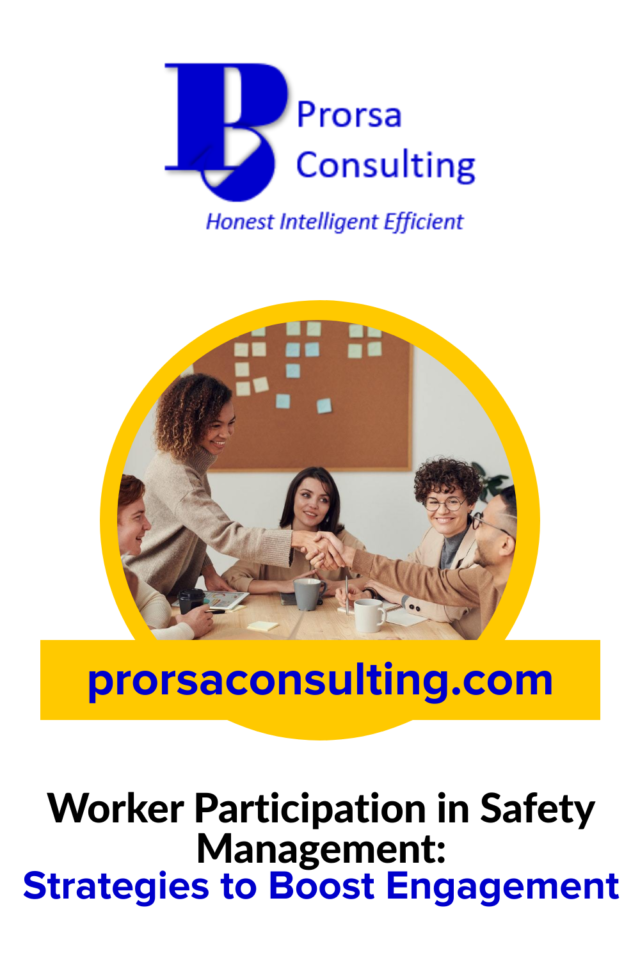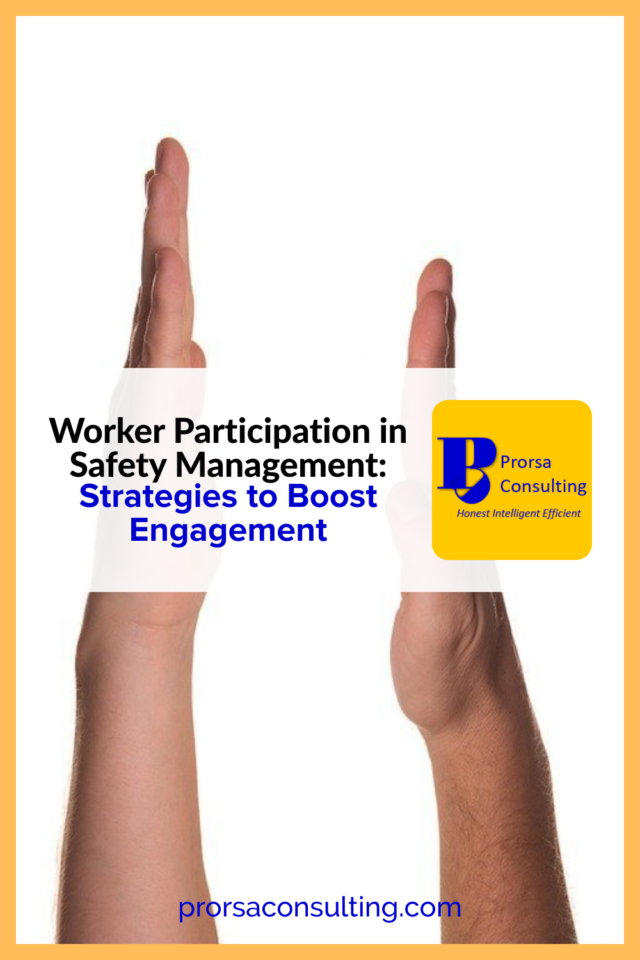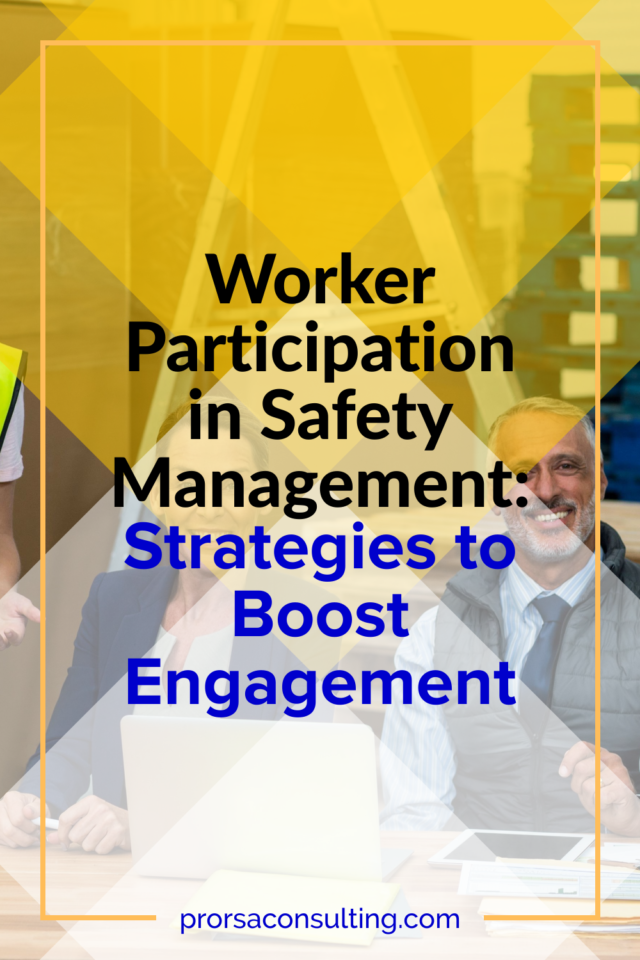Worker Participation in Safety Management: Strategies to Boost Engagement
By : Admin -

Disengaged workers can tank even the most resiliently crafted safety program with little to no effort.
After all, it only takes the slightest amount of determination to stay uninvolved. Without worker participation in safety management, the efforts to safeguard employees undeniably fail.
Numerous avenues exist to reach participation goals and realize the associated safety performance benefits. Yet, employers must stay vigilant to actively provide a collaborative environment and persuade individuals to engage in safety in the workplace.
Keep reading below for strategies to help employee safety participation stay at the forefront of your program efforts.
Cultivating a Cooperative Atmosphere for Worker Participation in Safety Management
Without the right environment, efforts to increase employee engagement will wither. Nurturing a suitable space that promotes free safety speech, empowers employees, and provides follow-up on progress goes quite a way to support the businesses’ participation goals.
Promote Free Safety Speech
The fear of retaliation breeds silence. The ensuing environment cultivates stunted reporting and failures to ask for assistance when needed. As a result, supervisors, managers, and leaders ultimately remain unaware of the unsafe happenings at the site, leaving workers and the company at risk.
Yet, encouraging free safety speech can help to combat hiding, coverups, and omissions. Companies must have a policy of reprisal-free reporting to keep the lines of communication open.
When communicating a rule like this one, businesses should clarify to employees that disciplinary action can still be brought for any negligent or purposeful unsafe acts. However, workers shall not receive punishment for simply reporting incidents, injuries, or conditions with the potential to jeopardize safety.
Employers should also contemplate an open door strategy to encourage safety questions and discussions between supervisors and employees. Likewise, management must stay proactive in sharing the good actions and accomplishments associated with safety. Emphasizing only the unpleasant events and behaviors can dishearten the workforce.
Image by Rawpixel at Adobe Stock.
Empower Employee Participation in the Safety Program
Workers can certainly feel confined by the scope of their jobs at times. As such, they may not recognize the need to take ownership of safety throughout the facility. Furthermore, employees may believe they must seek permission for every activity, even the small ones, unrelated to their “normal” job duties.
Organizations should strive to remove these roadblocks to engagement. Let employees know that safety at all times within the facility falls in their scopes of influence.
Moreover, companies can communicate the expectation that individuals should correct unsafe conditions within and outside of their assigned workstations. If workers cannot efficiently resolve these circumstances independently, they should promptly report the conditions for correction.
Additionally, businesses should consider giving workers stop work authority when unsafe conditions could immediately harm individuals or cause property damage. By empowering workers with dangerous condition correction and stop work authority permissions, facilities can realize better outcomes through worker participation in safety management.

Image by Jan Antonin Kolar at Unsplash.com.
Regularly Follow-up on the Organization’s Actions to Safeguard the Workforce
Virtuous deeds generate more virtuous deeds. Receiving updates on the company’s work to promote a safe environment shows trust and care to employees. This action will increase workers’ desires to help achieve the business’s goals to safeguard all.
So, organizations need to commit to the communication of safety progress as a regular part of doing business. Operations can do this by giving briefings on safety issues during business meetings.
Additionally, you can utilize bulletin and video boards to post safety results. Newsletter, email or text messages, and the company’s intranet site serve as additional vehicles for safety progress communications.
Businesses must ensure individuals reporting safety issues receive proper updates on their identified concerns. Nothing depresses morale more than proactive efforts being met with perceived indifference due to a lack of communication.

Image by Gerd Altmann at Pixabay.com.
Providing Numerous Opportunities to Engage for Heightened Worker Participation in Safety Management
Many avenues exist for employee participation in safety programs. However, it may be difficult for businesses to determine what will work for their facilities with so many choices. So, let us cover eleven universal ways to boost worker safety engagement to take the guesswork out of the equation.
#1 – Suggestion Box
Asking for improvement recommendations provides an easy, cost-effective way to get workers involved in safety. Organizations would only need to provide a means to capture the suggestions (i.e., the box) and communicate to workers the box’s existence.
A safety suggestion box can provide anonymity to employees who fear reprisal, making this engagement tool a lower perceived risk.
After receiving responses, the organization would need to manage the mechanism for determining and implementing follow-up actions if the suggestion is accepted. Furthermore, the business will want to review and share updates on all implemented recommendations with the workforce.
#2 – Safety Observations
Behavior-based safety (BBS) observations give yet another possibility for worker participation in safety management. This type of initiative also has the added benefit of placing all employees, regardless of job title, on the same level because anyone could be subject to having their work observed at any time.
Observational initiatives also help employees hone their hazard and unsafe practices recognition skills. Similarly, a boost in the communication skills amongst employees of all levels will ensue from the rise in the number of safety discussions between workers.
#3 – Safety Committees
Safety committees have long been cornerstones of employee engagement at sites. These groups often give a voice to employees during the strategic decision-making associated with the safety program.
Plus, the committees may give support to safety personnel during project development and implementation activities. Members of these groups often are trusted within the larger workforce, making them ideal change management partners within the safety program.
#4 – Personal Risk Assessments
Personal Risk Assessments (PRAs) correspondingly supply an excellent means to enhance safety program participation. They cost nothing, and individuals can perform them in a little as five minutes. Yet, PRAs garner benefits beyond simple worker engagement.
These evaluations assist employees with their hazard recognition skills before performing any work. Depending on the desire to document them, PRAs may also provide valuable information to sites on work areas needing extra housekeeping or maintenance attention. Furthermore, facilities may use these exams in conjunction with the next engagement opportunity, safety incentive programs.
#5 – Safety Incentive Programs
The Occupational Safety and Health Administration (OSHA) states, “Incentive programs can be an important tool to promote workplace safety and health.” They also provide an exceptional answer to how to get workers involved in safety.
These initiatives can be individually-based, team-centered, or both. When designed well, they emphasize the positive, leading behaviors that reduce the likelihood of poor safety outcomes on-site.
However, businesses should be wary of establishing safety incentives that become entitlement programs or stifle incident or injury reporting over time. These situations often happen when the awards for goal achievement consist of lucrative cash or gift cards. Instead, try giving non-monetary prizes like meals, hours off, or promotional items in place of cold hard cash.

Image by Mohamed Hassan at Pixabay.com.
#6 – Safety Perception Surveys
Questionnaires give an additional method for workers to voice their opinions frankly and anonymously. Additionally, they can provide insight into workers’ attitudes about the overall safety program, its implementation, and the leadership heading the effort.
Moreover, safety perception surveys result in a snapshot progress report that can be utilized as a landmark to gauge future safety success within an organization. Using the findings of these types of opinion polls to collect feedback and identify areas for continuous cultural improvement creates opportunities for companies to kill multiple birds with one stone.
#7 – Develop a JHA or SOP
Job hazard analyses (JHA) and standard operating procedures (SOP) help control risks in the workplace when used correctly. Developing these documents presents a superb way to further worker participation in safety management because employees who do the work tasks know the risks and the steps necessary to avoid them better than anyone.
Furthermore, allowing workers to engage in the JHA or SOP process relieves strain on EHS personnel resources. It also increases trust between management and workers as it can be a show of faith that workers know what they are doing and can handle the job.

Image by Andrzej Rembowski at Pixabay.com.
#8 – Contests
Holding safety contests may promote healthy competition, boost morale, and will likely breed even more workforce involvement in health and safety. A business can conduct contests for anything from naming a new safety initiative to completing the most PRAs or safety observations within a specific timeframe.
Also, the prizes for contests do not have to elaborate or expensive. Yet, they should be meaningful to workers. Items like the opportunity to shadow the plant manager for a day, a $200 donation to the winner’s choice of charity, or an extra vacation day would serve as great rewards for most employees. Just remember to use contests sparingly to keep them unique and significant.
#9 – Design or Lead Safety Training
Safety training serves as an essential part of any safety program. It also gives an excellent avenue for workers to get more involved. Moreover, allowing employees to design or lead training helps convey the organization’s trust in them as experts at what they do.
Many possibilities exist for individuals to engage in training design or facilitation. For example, workers can collect pictures or star in videos utilized in training. They may provide questions for competency tests or share their knowledge by teaching the class.
Furthermore, employees may conduct demonstrations showcasing proper procedures. In any capacity, involvement in the training design and facilitation engenders greater ownership on behalf of the employees.

Image by Wavebreak Media Micro at Adobe Stock.
#10 – Conduct Audits and Inspections
Permitting employees to conduct formal audits and inspections of the workplace helps reinforce hazard identification skills and regulatory knowledge while providing a vehicle for engagement. Likewise, it gives employees an avenue to recommend solutions to potential problems.
Engagement often stems from a feeling of duty or responsibility or the anticipated recognition of a job well done. Giving employees responsibility for identifying potential improvement opportunities and positively acknowledging them for their contributions will support future desires to participate.
#11 – Safety Mentorship
Instituting a safety mentorship program helps get workers involved in safety and spread organizational knowledge throughout the workforce. By pairing more experienced employees with less-skilled individuals, both parties and the company will see wins.
Teaching reinforces knowledge of the subject matter for the mentors. The mentees bring a fresh perspective and may recognize safety gaps the mentor never identified. Both individuals have the potential to learn from each other, thus promoting a stronger bond and ownership for each other’s safety.
Replicating this process within the organization amplifies the return on investment in employee ownership and safety participation.
Related Safety Management Participation Posts
Dear Noncompliance: Meet the Quick 16 Safety Walkthrough Inspection
Performing a Job Hazard Analysis: Your Powerful Weapon to Prevent Workplace Injuries
How to Craft an Informative EHS Awareness Program for Continued, High-Value Business Wins
Shielding Success: The Vital Role of EHS in Small Business Operations
Final Thoughts
Employees will encounter safety program involvement obstacles without an encouraging environment and designed avenues for engagement. Do not allow your workforce to disengage by ignoring the need for worker participation in safety management.
We encourage feedback on this blog. Please like, comment, and share this valuable content to help others. You can also leave your thoughts via our Contact Us page.
Also, do not forget to follow Prorsa Consulting on LinkedIn, Pinterest, and Twitter.
Prorsa Consulting helps regulated businesses assess, maintain, and enhance their environmental and safety compliance to reduce risk. Schedule a discovery call today to start down the path to better EHS program results.
Additional knowledge and resources can significantly impact your EHS program efforts in a positive way. Our Free Resources area may provide you with the extra support you seek. You can gain complimentary access by subscribing to the Prorsa Consulting Newsletter! Free EHS help is available to you. So, sign-up below and start leveraging the tools, presentations, and templates in the resources area to attain your EHS goals.





